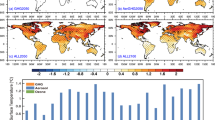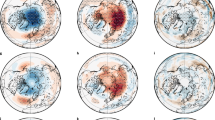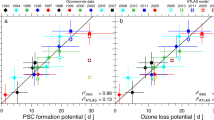Abstract
The rapid warming of the Arctic, perhaps the most striking evidence of climate change, is believed to have arisen from increases in atmospheric concentrations of GHGs1 since the Industrial Revolution. While the dominant role of carbon dioxide is undisputed, another important set of anthropogenic GHGs was also being emitted over the second half of the twentieth century: ozone-depleting2 substances (ODS). These compounds, in addition to causing the ozone hole over Antarctica, have long been recognized3 as powerful GHGs. However, their contribution to Arctic warming has not been quantified. We do so here by analysing ensembles of climate model integrations specifically designed for this purpose, spanning the period 1955–2005 when atmospheric concentrations of ODS increased rapidly. We show that, when ODS are kept fixed, forced Arctic surface warming and forced sea-ice loss are only half as large as when ODS are allowed to increase. We also demonstrate that the large impact of ODS on the Arctic occurs primarily via direct radiative warming, not via ozone depletion. Our findings reveal a substantial contribution of ODS to recent Arctic warming, and highlight the importance of the Montreal Protocol as a major climate change-mitigation treaty.
This is a preview of subscription content, access via your institution
Access options
Access Nature and 54 other Nature Portfolio journals
Get Nature+, our best-value online-access subscription
$29.99 / 30 days
cancel any time
Subscribe to this journal
Receive 12 print issues and online access
$209.00 per year
only $17.42 per issue
Buy this article
- Purchase on Springer Link
- Instant access to full article PDF
Prices may be subject to local taxes which are calculated during checkout




Similar content being viewed by others
Data availability
All model output analysed in the study is currently stored on data servers at the National Center for Atmospheric Research in Boulder, CO, USA, and are available from the corresponding author on request. The GISTEMP27 data are available at https://data.giss.nasa.gov/gistemp and the HadISST28 data can be found at https://www.metoffice.gov.uk/hadobs/hadisst2.
Code availability
All code used to produce the figures are available from the corresponding author on request.
References
Bindoff, N. L. et al. in Climate Change 2013: The Physical Science Basis (eds Stocker, T. F. et al.) 867–952 (IPCC, Cambridge Univ. Press, 2013).
Engel, A. et al. in Scientific Assessment of Ozone Depletion: 2018 Report No. 58, Ch. 1 (Global Ozone Research and Monitoring Project, 2018).
Ramanathan, V. Greenhouse effect due to chlorofluorocarbons: climatic implications. Science 190, 50–52 (1975).
Solomon, S. Stratospheric ozone depletion: a review of concepts and history. Rev. Geophys. 37, 275–316 (1999).
Farman, J. C., Gardiner, B. G. & Shanklin, J. D. Large losses of total ozone in Antarctica reveal seasonal ClOx/NOx interaction. Nature 315, 207–210 (1985).
World Meteorological Organization/United Nations Environmental Program Scientific Assessment of Ozone Depletion: 2018 Report No. 58 (Global Ozone Research and Monitoring Project, 2018).
Myhre, G. et al. in Climate Change 2013: The Physical Science Basis (eds Stocker, T. F. et al.) Ch. 8 (IPCC, Cambridge Univ. Press, 2013).
Young, P. J. et al. Agreement in late twentieth century Southern Hemisphere stratospheric temperature trends in observations and CCMVal-2, CMIP3, and CMIP5 models. J. Geophys. Res. Atmos. 118, 605–613 (2013).
Son, S.-W., Tandon, N. F., Polvani, L. M. & Waugh, D. W. Ozone hole and Southern Hemisphere climate change. Geophys. Res. Lett. 36, L15705 (2009).
Kang, S., Polvani, L., Fyfe, J. & Sigmond, M. Impact of polar ozone depletion on subtropical precipitation. Science 332, 951–954 (2011).
Thompson, D. W. et al. Signatures of the Antarctic ozone hole in Southern Hemisphere surface climate change. Nat. Geosci. 4, 741–749 (2011).
Previdi, M. & Polvani, L. M. Climate system response to stratospheric ozone depletion and recovery. Q. J. R. Meteorol. Soc. 140, 2401–2419 (2014).
Ramanathan, V. et al. Climate–chemical interactions and effects of changing atmospheric trace gases. Rev. Geophys. 25, 1441–1482 (1987).
Shine, K. P. On the cause of the relative greenhouse strength of gases such as the halocarbons. J. Atmos. Sci. 48, 1513–1518 (1991).
Hodnebrog, Ø. et al. Global warming potentials and radiative efficiencies of halocarbons and related compounds: a comprehensive review. Rev. Geophys. 51, 300–378 (2013).
Meinshausen, M. et al. The RCP greenhouse gas concentrations and their extensions from 1765 to 2300. Climatic Change 109, 213 (2011).
Forster, P. et al. in Climate Change 2007: The Physical Science Basis (eds Solomon, S. et al.) Ch. 2 (IPCC, Cambridge Univ. Press, 2007).
Velders, G. J., Andersen, S. O., Daniel, J. S., Fahey, D. W. & McFarland, M. The importance of the Montreal Protocol in protecting climate. Proc. Natl Acad. Sci. USA 104, 4814–4819 (2007).
Estrada, F., Perron, P. & Martínez-López, B. Statistically derived contributions of diverse human influences to twentieth-century temperature changes. Nat. Geosci. 6, 1050–1055 (2013).
Overland, J., Walsh, J. & Kattsov, V. in Snow, Water, Ice and Permafrost in the Arctic (SWIPA) 2017 9–24 (Arctic Monitoring and Assessment Programme, 2017).
Vaughan, D. et al. in Climate Change 2013: The Physical Science Basis (eds Stocker, T. F. et al.) Ch. 4 (IPCC, Cambridge Univ. Press, 2013).
Kay, J. et al. The Community Earth System Model (CESM) large ensemble project: a community resource for studying climate change in the presence of internal climate variability. Bull. Am. Meteorol. Soc. 96, 1333–1349 (2015).
Deser, C., Phillips, A., Bourdette, V. & Teng, H. Uncertainty in climate change projections: the role of internal variability. Clim. Dynam. 38, 527–546 (2012).
Hansen, J. E. et al. Efficacy of climate forcings. J. Geophys. Res. Atmos. 110, D18104 (2005).
Soden, B. J. et al. Quantifying climate feedbacks using radiative kernels. J. Clim. 21, 3504–3520 (2008).
Pithan, F. & Mauritsen, T. Arctic amplification dominated by temperature feedbacks in contemporary climate models. Nat. Geosci. 7, 181–184 (2014).
Hansen, J., Ruedy, R., Sato, M. & Lo, K. Global surface temperature change. Rev. Geophys. 48, RG4004 (2010).
Titchner, H. A. & Rayner, N. A. The Met Office Hadley Centre sea ice and sea surface temperature data set, version 2: 1. sea ice concentrations. J. Geophys. Res. Atmos. 119, 2864–2889 (2014).
Jahn, A., Kay, J. E., Holland, M. M. & Hall, D. M. How predictable is the timing of a summer ice-free Arctic? Geophys. Res. Lett. 43, 9113–9120 (2016).
Labe, Z., Magnusdottir, G. & Stern, H. Variability of Arctic sea ice thickness using PIOMAS and the CESM large ensemble. J. Clim. 31, 3233–3247 (2018).
England, M. R., Jahn, A. & Polvani, L. M. Nonuniform contribution of internal variability to recent Arctic sea ice loss. J. Clim. 32, 4039–4053 (2019).
Marsh, D. R. et al. Climate change from 1850 to 2005 simulated in CESM1 (WACCM). J. Clim. 26, 7372–7391 (2013).
Gettelman, A., Kay, J. & Shell, K. The evolution of climate sensitivity and climate feedbacks in the community atmosphere model. J. Clim. 25, 1453–1469 (2012).
Conley, A., Lamarque, J.-F., Vitt, F., Collins, W. & Kiehl, J. Port, a CESM tool for the diagnosis of radiative forcing. Geosci. Model Dev. 6, 469–476 (2013).
Taylor, K. E., Stouffer, R. J. & Meehl, G. A. An overview of CMIP5 and the experiment design. Bull. Am. Meteorol. Soc. 93, 485–498 (2012).
Previdi, M. Radiative feedbacks on global precipitation. Environ. Res. Lett. 5, 025211 (2010).
Previdi, M. & Liepert, B. G. The vertical distribution of climate forcings and feedbacks from the surface to top of atmosphere. Clim. Dynam. 39, 941–951 (2012).
Roe, G. Feedbacks, timescales, and seeing red. Annu. Rev. Earth Planet. Sci. 37, 93–115 (2009).
Pendergrass, A. G., Conley, A. & Vitt, F. M. Surface and top-of-atmosphere radiative feedback kernels for CESM-CAM5. Earth Syst. Sci. Data 10, 317–324 (2018).
Acknowledgements
All computations were performed with resources provided by the Computational and Information Systems Laboratory at the National Center for Atmospheric Research, which is sponsored by the US National Science Foundation. The historical CAM5LE integrations were performed by the Large Ensemble22 Project. This research was funded by two grants from the USNSF to Columbia University. L.M.P. is grateful to J. Kay, and the other organizers, for the opportunity to attend the 2018 CESM Polar Modeling Workshop in Boulder, CO, USA. The authors are indebted to P. Forster and J. Fyfe for suggesting an important clarification.
Author information
Authors and Affiliations
Contributions
L.M.P. designed the study, carried out WACCM4 integrations and wrote the first draft of the manuscript. M.P. suggested and performed feedback analysis. M.R.E. carried out CAM5LE integrations and helped with their analysis. G.C. computed radiative forcing with the PORT model. K.L.S. helped with analysis of WACCM4 integrations. All authors contributed to the interpretation of the results and to the drafting of the final manuscript.
Corresponding author
Ethics declarations
Competing interests
The authors declare no competing interests.
Additional information
Peer review information Nature Climate Change thanks Francisco Estrada and the other, anonymous, reviewer(s) for their contribution to the peer review of this work.
Publisher’s note Springer Nature remains neutral with regard to jurisdictional claims in published maps and institutional affiliations.
Extended data
Extended Data Fig. 1 Seasonal changes, 1955-2005.
Monthly, ensemble-mean, 1955-2005 change in (a) global and (b) Arctic surface air temperature (\({{\rm{T}}}_{{\rm{s}}}\)) and (c) Sea Ice Extent (SIE, the total area with sea ice concentration exceeding 15%), in the CAM5LE model. On the curves for the FixODSO3 and FixODS ensembles, small and large circles highlight the months in which the difference with the Historical ensemble is statistically significant at the 95% and 99% level, respectively, (from a two-tailed t-test).
Extended Data Fig. 2 Arctic amplification, 1955-2005.
Arctic amplification factor for the three CAM5LE ensembles over the period 1955-2005. The factor is defined as the annual mean surface air temperature change over the Arctic (60-90\({}^{\circ }\) N) divided by the corresponding global mean change. The boxes extend from the lower to upper quartile, with a line at the median, and with whiskers showing the entire range across each ensemble; the individual members are shown by the small black dots. The difference between the means of the FixODSO3 and Historical ensembles is statistically significant at the 95% level.
Extended Data Fig. 3 Synthetic PDFs of 1955-2005 changes.
Probability distribution functions (PDFs) of annual global surface temperature change (top), Arctic surface temperature change (middle), and September sea ice loss computed from the Historical (red) and FixODSO3 (blue) simulations with the CAM5LE model. These PDFs are constructed by ‘resampling with replacement’ âĂŞ 10,000 times âĂŞ the original set of 10 model simulations.
Extended Data Fig. 4 Arctic surface temperature and sea ice trends, 1955-2005.
As in Fig. 2, but for the WACCM4 model integrations.
Extended Data Fig. 5 Arctic feedbacks, 1955-2005.
As in Fig. 4, but for the WACCM4 model integrations.
Rights and permissions
About this article
Cite this article
Polvani, L.M., Previdi, M., England, M.R. et al. Substantial twentieth-century Arctic warming caused by ozone-depleting substances. Nat. Clim. Chang. 10, 130–133 (2020). https://doi.org/10.1038/s41558-019-0677-4
Received:
Accepted:
Published:
Issue Date:
DOI: https://doi.org/10.1038/s41558-019-0677-4
This article is cited by
-
Projections of an ice-free Arctic Ocean
Nature Reviews Earth & Environment (2024)
-
Global increase of ozone-depleting chlorofluorocarbons from 2010 to 2020
Nature Geoscience (2023)
-
Quantifying contributions of ozone changes to global and arctic warming during the second half of the twentieth century
Climate Dynamics (2023)
-
Stratospheric ozone, UV radiation, and climate interactions
Photochemical & Photobiological Sciences (2023)
-
The response of aquatic ecosystems to the interactive effects of stratospheric ozone depletion, UV radiation, and climate change
Photochemical & Photobiological Sciences (2023)



